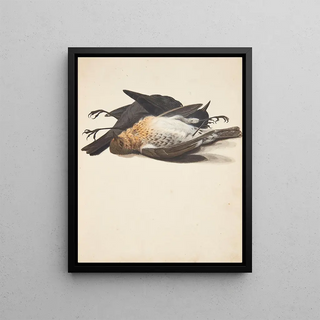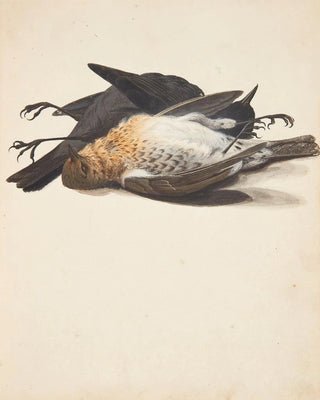Art print | Study of two dead bodies, black sun, male and female, lying down - Johanna Fosie


View from behind

Frame (optional)
"Étude de deux morts soleil noir mâle et femelle couchés" by Johanna Fosie stands as a poignant exploration of the duality between life and death. In this piece, the artist masterfully captures the very essence of the human condition through the depiction of two bodies, revealing a haunting beauty and subtle melancholy. The light, seemingly emanating from the background, envelops the figures in a mysterious aura, while the intricate details of the bodies testify to a deep respect for the fragility of existence. This artwork invites viewers to an introspective reflection on mortality, while celebrating the ephemeral beauty of life.
Style and uniqueness of the work
Johanna Fosie’s style is distinguished by a blend of realism and poetry. In "Étude de deux morts soleil noir mâle et femelle couchés," the artist combines elements of naturalism with symbolic interpretation, creating a piece rich in meaning. The bodies, although depicted in their eternal repose, seem to vibrate with a silent energy, as if their essence persists beyond death. The color palette chosen by Fosie, oscillating between dark tones and lighter shades, reinforces this duality. Every brushstroke is charged with emotion, and the texture of the surfaces invites prolonged contemplation. In this sense, the work is not merely a painting; it becomes a space for dialogue between the visible and the invisible, between life and absence.
The artist and her influence
Johanna Fosie is a contemporary artist whose work is rooted in a rich artistic tradition, while bringing a unique voice to the current scene. Trained at prestigious art schools, she has developed a visual language that is entirely her own, blending classical and contemporary influences. Her work often questions themes of mortality, memory, and fleeting beauty—subjects that resonate deeply within our modern society. Drawing from historical references while adopting innovative techniques, Fosie manages to create pieces that transcend

Matte finish

View from behind

Frame (optional)
"Étude de deux morts soleil noir mâle et femelle couchés" by Johanna Fosie stands as a poignant exploration of the duality between life and death. In this piece, the artist masterfully captures the very essence of the human condition through the depiction of two bodies, revealing a haunting beauty and subtle melancholy. The light, seemingly emanating from the background, envelops the figures in a mysterious aura, while the intricate details of the bodies testify to a deep respect for the fragility of existence. This artwork invites viewers to an introspective reflection on mortality, while celebrating the ephemeral beauty of life.
Style and uniqueness of the work
Johanna Fosie’s style is distinguished by a blend of realism and poetry. In "Étude de deux morts soleil noir mâle et femelle couchés," the artist combines elements of naturalism with symbolic interpretation, creating a piece rich in meaning. The bodies, although depicted in their eternal repose, seem to vibrate with a silent energy, as if their essence persists beyond death. The color palette chosen by Fosie, oscillating between dark tones and lighter shades, reinforces this duality. Every brushstroke is charged with emotion, and the texture of the surfaces invites prolonged contemplation. In this sense, the work is not merely a painting; it becomes a space for dialogue between the visible and the invisible, between life and absence.
The artist and her influence
Johanna Fosie is a contemporary artist whose work is rooted in a rich artistic tradition, while bringing a unique voice to the current scene. Trained at prestigious art schools, she has developed a visual language that is entirely her own, blending classical and contemporary influences. Her work often questions themes of mortality, memory, and fleeting beauty—subjects that resonate deeply within our modern society. Drawing from historical references while adopting innovative techniques, Fosie manages to create pieces that transcend






